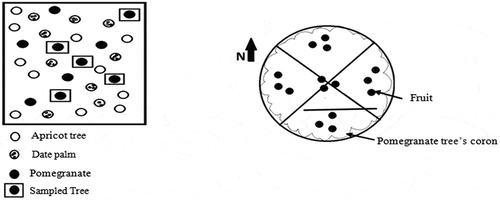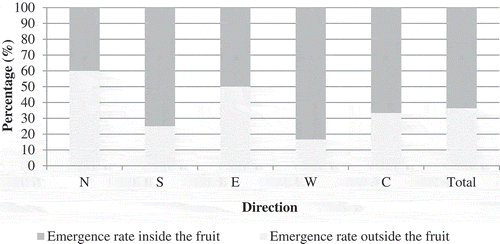 ?Mathematical formulae have been encoded as MathML and are displayed in this HTML version using MathJax in order to improve their display. Uncheck the box to turn MathJax off. This feature requires Javascript. Click on a formula to zoom.
?Mathematical formulae have been encoded as MathML and are displayed in this HTML version using MathJax in order to improve their display. Uncheck the box to turn MathJax off. This feature requires Javascript. Click on a formula to zoom.ABSTRACT
Pomegranate trees are susceptible to many pests. Marketing quality of pomegranate fruits is mainly affected by the pomegranate butterfly Virachola livia. This study aimed to determine some bio-ecological parameters of Virachola livia (Klug) and the evaluation of their damages on pomegranate (Punica granatum) in the region of Djanet (Southeastern of Algeria). The percentage of infestation was 78.7% according to the penetration holes. However, depending on the number of eggs, it was 69.3%. The number of penetration holes and eggs by fruit varied between 1 and 24 (7.8 ± 5.7) holes/fruit and 1 to 15 (4.2 ± 3) eggs/fruit, respectively. The pupae stages last from 5 to 8 days (6.9 ± 1.2 days). The females can live between 8 and 16 days (10.9 ± 2.5 days), whereas the longevity of males varied between 4 and 11 days (8.8 ± 2.9 days).
Introduction
Pomegranate trees (Punica granatum L.) are susceptible to many diseases and pests, in particular Ceratitis capitata (Wiedemann), Ectomylois ceratonia (Zeller) and Virachola livia (Klug) (Lepidoptera, Lycaenidae) (Braham, Citation2015; Sayed and Temarek, Citation2007). This last one caused a serious damage in many countries of the world, such as in Jordan (Obeidat and Akkawi, Citation2002), Oman (Abbas et al., Citation2008; Kinawy et al., Citation2008), Egypt (Sayed et al., Citation2010) and Tunisia (Ksentini et al., Citation2011). This species is also declared as a pest of the date palm in Morocco (Sedra, Citation2003) and Tunisia, where it was detected for the first time in 2011 (Zouba and Chermiti, Citation2015). Moreover, it can affect by other species such as Ceratonia siliqua, Vicia faba, Prunus salicina, Eriobotrya japonica, Acacia ssp. and Psidium spp. (Awadallah et al., Citation1970; Gentry, Citation1965; Hanna, Citation1939).
According to Obeidat and Akkawi (Citation2002), the percentage of damage can reach to 48% on pomegranate in Jordan. However, there is no information on this agronomically harmful species in Algeria. The aim of this study was to be the follow-up of some bio-ecological parameters of V. livia and its impact on pomegranate in the extreme Southeast of Algeria. The obtained knowledge is necessary for developing successful management for this key pest of pomegranate.
Materials and Methods
Choice of the Study’s Stations
This study was conducted in a Djanet area (24° 31ʹ to 24° 34ʹ N; 9° 27ʹ to 9° 29ʹ E). The area is located in the extreme Southeast of Algeria at about 2,200 km far from Algiers. It is a Saharan region localized in the area of Tassili n’Ajjer, at 1,094 m a.s.l. Our study area is limited by Libya in the East, Niger in the South, Tamanrasset at North, and in the Southeast by Bordj El Haoes. This area is characterized by a Saharan climate with hot summers and mild winter’s (from 2006 to 2016). In this region, two stations were selected:
Station 1 (Elmihan Palm Plantation)
This station extends over an area of 0.5 ha. It was irrigated by submersion. The Palm trees Phoenix dactylifera L. we are arranging in a random way, they were accompanied by Punica granatum, Vitis vinifera, Prunus armeniaca, Medicago sativa, and some other gardening crops like Solanum lycopersicum, Vicia faba, and Citrullus lanatus.
Station 2 (Tin Ouraghen Palm Plantation)
This station extends over an area of 0.5 ha, also irrigated by submersion. In the same way, the date palms were strewed with a disordered way; it is the case of other species, in particular, Citrus sinensis, Punica granatum, Vitis vinifera, and Prunus armeniaca. Other vegetables were reported (Medicago sativa, Panicum miliaceum, Solanum lycopersicum, and Vicia faba) in this station.
Sampling Methods
The fruits were collected during the swelling period of fruits (May and June). Five pomegranate trees were randomly selected and inspected. Five fruits were collected from each tree, with one fruit from each direction (North, South, East, West, and center) of the canopy ().
Estimate of the Percentage of Damage
At the laboratory, we proceeded to the counting of eggs and holes of penetration and exit. The percentage of damage was evaluated by the following function (Silvie and Gozé, Citation1991):
According to the previous protocol, the fruits sampling was put in covered box to study the following biological parameters.
Biology of Virachola Livia
Duration of the Nymphal Stage
The collected pupae were separately put in petri dishes until the emergence in order to determine the nymphal stage duration, which corresponds to the interval between the formation of the chrysalis and the emergence of the adult.
Emergence Percentage
The emergence percentage was estimated by the report of the number of emerging pupae on the total number of pupae, brought out of some fruits of pomegranate, expressed in percentage. It was calculated by the following function (Le Goff et al., Citation2016):
Longevity of Adults and Female’s Fecundity
Once emerged, the adults were installed in plastic boxes containing a nutritious liquid (water + sugar) to calculate the longevity (male and female) and the number of eggs laid by virgin females.
All statistical analyses were realized by Minitab software (version 17.1.0.0). For data comparison, we have used ANOVA in the case of normal data and the Kruskal Wallis test for the abnormal data. The results were reported as significant for p < .01.
Results
Estimation of the Damages
The percentage of damage causing by Virachola livia on the pomegranate tree was estimated by the number of eggs and holes of penetration of larvae by fruit ().
Table 1. Variation of a number of eggs and penetration holes of Virachola livia’s larvae according to the stations of study
The number of V. livia eggs of pomegranate fruits in the area of Djanet ranged from 1 to 15 eggs/fruit (mean = 4.2 ± 3.0). Based on the presence of eggs on fruit, the percentage of damage was 70.5% (). However, the number of the penetration holes ranged from 1 to 24 holes/fruit (mean = 7.9 ± 5.7). The percentage of damage was 78.7%. According to the stations, there were significant differences between the station (p < .0001). Indeed, in station 2, the damage was very important in pomegranate fruits with 85.3%, representing the number of eggs and 89.3% the number of the penetration holes ().
Figure 2. Number of eggs (Nbr.w.) and penetration holes (Nbr.p.) of larvae of Virachola livia per fruit in both stations
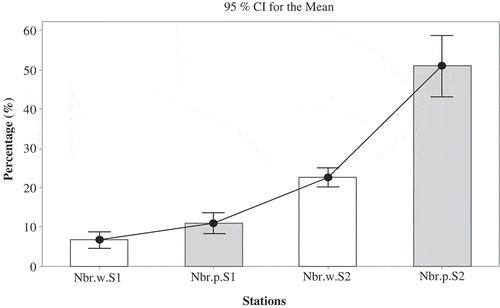
The coefficient of variation was relatively high for the number of eggs (CV = 86.5%) with pomegranate fruits in the first station compared to the number of the penetration holes (CV = 65.6%) (). Similarly, the same results were recorded in the second station. Generally, the fruit sampled of the pomegranate tree in the study area was characterized by a percentage of penetration holes (72.4%) almost similar to the percentage of oviposited egg on pomegranate fruits (70.5%) ().
The percentage of fruits affected by V. livia was relatively high. It was 69.3% concerning eggs and 78.7%, representing the penetration holes of caterpillars (). The comparison between these two parameters showed that the penetration holes (67.8%) are twice as high as the number of eggs (32.2%).
The number of eggs counted on the pomegranate fruits in the first station presented a significant correlation (r = 0.61; p < .0001) with the penetration holes of larvae inside fruits (). Likewise, similar results were reported in the second station (r = 0.58; p < .0001).
Table 2. Matrix of similarity between eggs and penetration holes number of V. livia on pomegranate tree in both stations of study. Values of Pearson’s correlation (r) under the diagonal and the values of probability (p) above the diagonal
According to cardinal directions, the number of penetration holes is higher than the number of oviposited eggs (). The highest number of eggs was recorded on the fruits in center direction (15 eggs; mean = 7.4 ± 4.0), followed by the east direction in the second rank (14 eggs; mean = 4.6 ± 3.6) (). However, the highest number of penetration holes of larvae is recorded in the north direction (24 holes of penetration; mean = 9.8 ± 5.2), followed by the center direction (22 holes of penetration; mean = 13.7 ± 6.2).
Table 3. Variation of eggs and penetration’s holes of Virachola livia’s larvae according to the directions
Figure 3. Variation of eggs (Nbr.w) and penetration holes (Nbr.p) of V. livia on pomegranates according to the directions
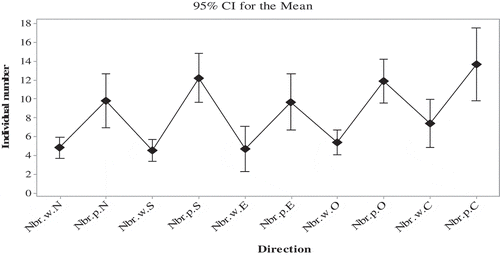
The coefficient of variation recorded for the number of eggs was low on the pomegranate fruits in the west direction (CV = 40.5%), whereas the highest value was reported in the east direction (CV = 77.3%). While, for the penetration holes of the larvae, the minimum value was noted in the west direction (CV = 34.0%), however, the maximum value was recorded in the north direction (CV = 52.8%).
The percentages of affected pomegranate fruits according to oviposited eggs by V. livia ranged from 60% (east direction) to 80% (south direction). For the penetration holes, the percentage ranged from 56.7% (east direction) to 93.3% (west direction). Moreover, the exit holes showed their highest values in the south direction (57.1%) and the lowest values were noted in the east direction (41.7%) ().
Data on the Bioecology of Virachola Livia
The length of pupae varied between 10 and 12 mm (mean = 11.3 ± 0.6 mm) (). While the big width varied between 4 and 5 mm (mean = 4.8 ± 0.3 mm). As for the adults, the males (16.2 ± 1.1 mm) have a size relatively smaller than the females (19.6 ± 1.2 mm).
Table 4. Morphometry of pupae and adults of Virachola livia.
The duration of the pupae stages was 6.9 ± 1.3 days (). The longevity of the male adults of this butterfly was 11 days, while the longevity of females was 16 days.
Table 5. Pupae stages duration, adult’s longevity, and fecundity of virgin females
The percentage of emergence was 66.7% (). This percentage was high on the fruits in the west and center direction (100%), while, the percentage of emergence was low on the fruits in the south direction (50%).
Figure 5. Percentage of emergence and mortality of Virachola livia pupae according to the directions
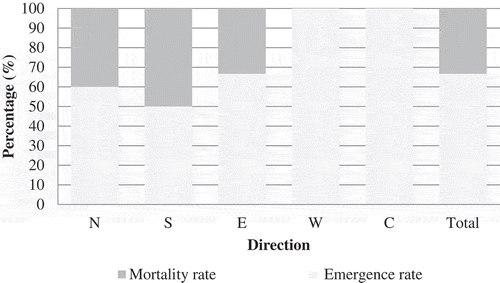
It was to be noted that the pupae emergence of V. livia is made as well with the fruit as outside in the superficial layers of soil (). The percentage of pupae emerged inside fruit was 63.6%, while those who emerged outside was 36.4%. The majority of pupae were emerging on the fruits in the west direction (83.3%), whereas in the northern pomegranate tree, the pupae preferred to emerge from the soil (60%). The emergence of pupae was giving, especially females (71.4%) more than males (28.6%).
Discussion
Damage Caused by Virachola Livia
The percentage of pomegranate fruits containing eggs of V. livia was 70.5%. Each fruit contained 4.2 ± 3.0 eggs/fruit, while 78.7% of fruits contained penetration holes (mean = 7.9 ± 5.7 holes/fruit). Several authors showed that V. livia was the most important pest of the pomegranates in many countries, in particular in Egypt (Sayed and Temerak, Citation2007), Tunisia (Gharbi, Citation2010; Ksentini et al., Citation2011), Jordan (Obeidat and Akkawi, Citation2002) and Oman (Abbas et al., Citation2008; Kinawy et al., Citation2008). Under laboratory rearing, Gharbi (Citation2010) noted that the female could lay until 13.1 ± 3.18 egg/fruit. In a pomegranate tree orchard with 4 years old, Kahramanoglu and Usanmaz (Citation2013) reported that 276 ± 21 fruits were damaged among 1,889 ± 116 fruits examined.
Significant differences were found between the station (p < .0001). Indeed, in the second station, the damage was very important in pomegranate fruits with 85.3% of the number of eggs and 89.3% of the number of the penetration holes. In Tunisia, the infestation made up 52.0% in some areas (Ksentini et al., Citation2011). Similarly, Kahramanoglu and Usanmaz (Citation2013) reported that D. livia was determined as the highest damaging pest with 14.63% of damage in 2011 and 15.57% of damage in 2012 in the untreated control treatments. On the other hand, Elsayed and Bazaid (Citation2011) noted that the highest percentage of infestation was observed in August (17.5%), while the lowest was noted in October. Other authors mentioned the high infestations in May (Mokhtar and Al Nabhani, Citation2016) and in July (Pareek, Citation1982; Patyal and Nath, Citation1993).
The percentage of fruits affected by V. livia are relatively high, was 69.3% concerning eggs and 78.7% for the penetration holes of caterpillars. Obeidat and Akkawi (Citation2002) recorded that the percentage of infestations were 48.0% in Jordan. The number of eggs counted on the pomegranate fruits in station 1 presented a significant correlation (r = 0.61; p < .0001) with the penetration holes of larvae inside fruits (). Likewise, similar results were reported at the station 2 (r = 0.58; p < .0001). More eggs were important; the penetrations were very significant, which reflects the high fertility of this species.
The percentages of affected pomegranate fruits according to oviposited eggs by V. livia ranged from 60% (east direction) to 80% (south direction). Similar results were recorded by Mokhtar and Al Nabhani (Citation2016) in Jordan.
The highest number of eggs was recorded on the fruits in center direction (15 eggs; mean = 7.4 ± 4.0), followed by the east direction in the second rank (14 eggs; mean = 4.6 ± 3.6). Mokhtar and Al Nabhani (Citation2016) noted that the highest number of eggs was recorded on the fruits of the northern direction (31.6%), followed by those of the eastern direction (28.2%), the west direction (21.1%), and the south direction (19.2%). For the penetration holes, the percentage ranged from 56.7% (east direction) to 93.3% (west direction). Moreover, the exit holes showed their highest values in south direction (57.1%) and the lowest noted in the east direction (41.7%). These variations were almost certainly related to the climatic factors, in particular temperature and exposure time of fruits to the sunlight, which affected directly the cycle of this pest.
Mokhtar and Al Nabhani (Citation2016) suggest that several factors may contribute to the distribution of V. livia eggs on the pomegranate fruits as follows:
- Factors causing aggregation such as resource limitation involving short season of pomegranate fruits; suitability of the fruit physical status for oviposition during the relatively short life of the butterfly females; and high competition on preferable oviposition sites.
- Factors causing avoidance such as carrying capacity of the pomegranate fruits; and cannibalism behavior in larval stage.
Data on the Bioecology of Virachola Livia
The length of pupae varied between 10 and 12 mm (mean = 11.3 ± 0.6 mm) (). While the big width varied between 4 and 5 mm (mean = 4.8 ± 0.3 mm). These results confirm those of Avidov (Citation1958) who mentioned lengths was varying between 11 and 12 mm of the pupae. As for the adults, the males (16.2 ± 1.1 mm) have a size relatively smaller than the females (19.6 ± 1.2 mm). A similar dimension was already observed on the male pupae (8.1 ± 0.0 mm) and females (10.9 ± 0.0 mm) by Mkaouar and Ben Jamâa (Citation2016).
The duration of the pupae stages was 6.9 ± 1.3 days. This duration was relatively lower than that noted by Gharbi (Citation2010) in Tunisia, where mentioned that duration of pupae stages equal to 10.1 ± 0.7 days. It is to be noted that the region of the study was situated in the central Sahara, where extreme temperatures can be recorded, what affecting directly the biological cycle.
The longevity of male adults of this butterfly was 11 days, while the longevity of females was 16 days. Gharbi (Citation2010) reported that the life cycle of 15.9 ± 1.1 days for the laying females and 12.1 ± 1.5 days for those who were fertilized. The same author added that longevity was negatively correlated with fertility.
The percentage of pupae emerged inside fruit was 63.6%, while those who emerged outside was 36.4%. The majority of pupae were emerging on the fruits in the west direction (83.3%), whereas in the northern pomegranate tree, the pupae preferred to emerge from the soil (60%). The lower number of pupae on pomegranate fruits in the north side of the tree canopy may be due to the effect of the sun, while those situated on the west side were characterized by pupation in the fruit. Globally, the emergence of pupae gives especially females (71.4%) more than males (28.6%). Gharbi (Citation2010) showed that on 29 pupae, 51.7% were females.
Conclusion
The pomegranate plantation of the southeast extreme of Algeria suffered from a new pest, which is Virachola livia. This caterpillar was considered as a real problem, especially that the presented percentage of damage relatively high varying between 69.3 (eggs) and 78.6 (penetration holes of caterpillar). It was presented certain requirements in terms of environmental condition, in particular the exhibition toward cardinal points and emergence. Finally, according to our preliminary observations, more investigation must be carried out in Algeria in order to better understand the biology and the behavior of this new pest.
References
- Abbas, M.S.T., S.A. Razvi, R.H. Shidi, and S.A. Al-Khatry. 2008. Role of egg parasitoids for controlling the pomegranate butterfly, Virachola livia Klug (Lycaenidae: Lepidoptera) in Sultanate of Oman. Proceedings of the second Arab Conference of Applied Biological Pest Control, Cario, Egypt, 7-10 April, Egypt. J. Biol. Pest Contr. 18 (1): 43-46.
- Avidov, Z. 1958. A study of a life history of pomegranate butterfly (Virachola livia Klug.) in Israel. Ktav. Rehov 8:153–167.
- Awadallah, A.M., A.K. Azab, and A.K.M. El Nahal. 1970. Studies on the pomegranate butterfly, Virachola livia (Klug) (Lepidoptera-Rhopalocera: Lycaenidae). Bull. Soc. Entomol. 62:545–567.
- Braham, M. 2015. Insect larvae associated with dropped pomegranate fruits in an organic orchard in Tunisia. J. Entomol. Nemat. 7(2):5–10. doi: 10.5897/JEN2015.0119.
- Elsayed, G., and S.A. Bazaid. 2011. Field investigation of pomegranate fruit worm in Taif and laboratory evaluation of Bacillus thuringiensis against Ectomyelois ceratoniae. Arch. Phytopath. Plant Prot. 44:28–36. doi: 10.1080/03235400902831075.
- Gentry, J.W. 1965. Crop insects of northeast Africa – Southwest Asia. Agriculture Handbook N° 273 (Ed). Agricultural Research Service, Washington, USA.
- Gharbi, N. 2010. Laboratory rearing of the pomegranate fruit butterfly Virachola livia on two host plants in Tunisia. Tunis. J. Plant Prot. 5(2):195–200.
- Hanna, A.D. 1939. The pomegranate fruit butterfly Virachola livia Klug. Morphology, Life-History and Control (Ed). Ministry of Agriculture, Cairo, Egypt.
- Kahramanoglu, I., and S. Usanmaz. 2013. Management strategies of fruit damaging pests of pomegranates: Planococcus citri, Ceratitis capitata and Deudorix (Virachola) livia. Afr. J. Agric. Res 8(49):6563–6568.
- Kinawy, M.M., H.M. Al-Waili, and A.M. Elmandhari. 2008. Review of the successful classical biological control programs in Sultanate of Oman. Proceedings of the 2nd Arab Conference of Applied Biological Pest Control, Cario, Egypt, 7-10, April Egypt. J. Biol. Pest Contr. 18(1): 1-10.
- Ksentini, I., T. Jardak, and N. Zeghal. 2011. First report on Virachola livia Klug. (Lepidoptera: Lycaenidae) and its effects on different pomegranate varieties in Tunisia. Bull. OEPP/EPPO 41: 178–182.
- Le Goff, G.J., A. Nicolas, R. Al Mohamad, and T. Hance. 2016. Impact of humidity on the biological development of aphidoletes aphidimyza (Diptera: Cecidomyiidae). J. Econ. Entomol. 1(5):1–5.
- Mkaouar, R., and M.L. Ben Jamâa. 2016. Study on biology of pomegranate playboy Deudorix livia, (Klug, 1834) in Acacia farnesiana. Ind. J. Appl. Res 6(8):160–161.
- Mokhtar, A.M., and S. Al Nabhani. 2016. Distribution of Virachola livia (Lepidoptera: Lycaenidae) egg and influence of conspecific aggregation and avoidance behavior. J. Agr. Sci. Tech. 18:1593–1604.
- Obeidat, W., and M. Akkawi. 2002. Bionomics and control of pomegranate butterfly Virachola (Deudorix) livia (Klug) (Lepidoptera: Lycaenidae) in Northern Jordan. Diras. Agri. Sci 29(1):1–12.
- Pareek, O.P. 1982. Survey, collection and identification of pomegranate pests of Udaipur. Pomegranate research report and appraisal.
- Patyal, S.K., and A. Nath. 1993. Efficacy and persistence of monocrotophos and phosphamidon on wild pomegranate. J. Entomol. Res. 17(2):111–116.
- Sayed, A.A., and S.A. Temerak. 2007. Alternate two green chemicals: Spinosad and methoxyfenozidz to combat Viracola livia on dates in Dakhla Oasis, New Valley, Egypt. The Fourth Symposium on Date Palm in Saudi Arabia, King Faisal University,Alahsa, 5-8 May: 1495–1501.
- Sayed, A.A., S.A. Temerak, and M. Lysandrou. 2010. The use of different insect control regimes using three green chemicals to combat Virachola livia on date palm fruit in Egypt. Acta Horticul., Proceedings of the fourth international date palm conference Abu Dhabi, United Arab Emirates, March 15-17, 882: 471–479.
- Sedra, M.H. 2003. Le palmier dattier base de la mise en valeur des oasis au Maroc, techniques phoénicicoles et Création d’oasis. INRA-Editions ed. Rabat Instituts, Maroc.
- Silvie, P., and E.E. Gozé. 1991. Estimation des pertes de production dues aux ravageurs du cotonnier au Tchad. Cot. Fib. Trop 46(1):15–32.
- Zouba, A., and B. Chermiti. 2015. Première estimation des dégâts causés par Virachola livia Klug (Lepidoptera: Lycanidae) sur palmier dattier en Tunisie. Premier Symposium National sur la Protection Intégrée des plantes, Tunis, Tunisie, 20-21 Avril.

